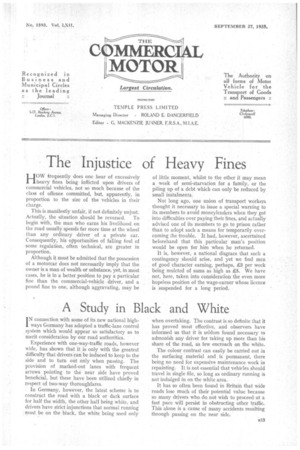A Study in Black and White IN connection with some
Page 23

If you've noticed an error in this article please click here to report it so we can fix it.
of its new national highways Germany has adopted a traffic-lane control system which would appear so satisfactory as to merit consideration by our road authorities.
Experience with one-way-traffic roads, however wide, has shown that it is only with the greatest difficulty that drivers can be induced to keep to the side and to turn out only when passing. The provision of marked-out lanes with frequent arrows pointing to the near side have proved beneficial, but these have been utilized chiefly in respect of two-way thoroughfares.
In Germany, however, the latest scheme is to construct the road with a black or dark surface for half the width, the other half being white, and drivers have strict injunctions that normal running .must be on the black, the white being used only when overtaking. The contrast is so definite that it has proved most effective, and observers have informed us that it is seldom found necessary to admonish any driver for taking up more than his share of the road, as few encroach on the white.
The colour contrast can easily be carried out in the surfacing material and is permanent, there being no need for expensive maintenance work in repainting. It is not essential that vehicles should travel in single file, so long as ordinary running is not indulged in on the white area. • It has so often been found in Britain that wide roads lose much of their potential value because so many drivers who do not wish to proceed at a fast pace will persist in obstructing other traffic. This alone is a cause of many accidents resulting through passing on the near side.




















































































